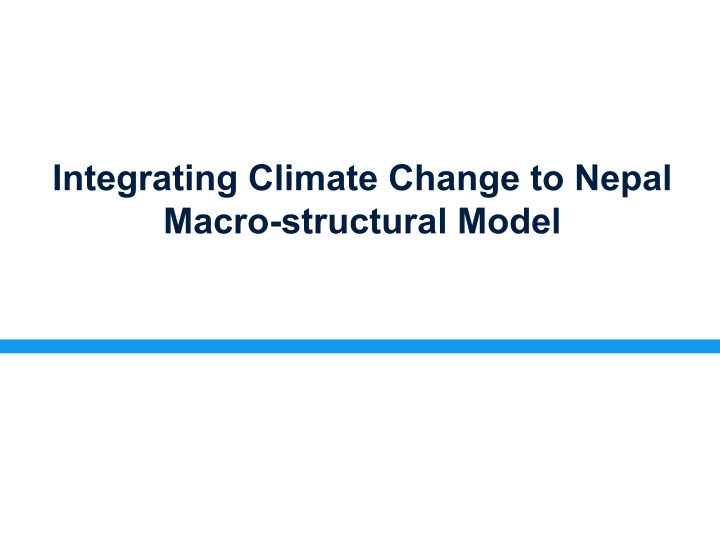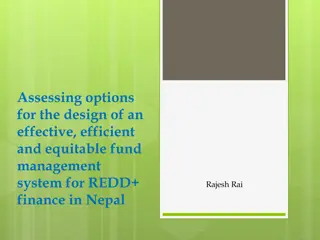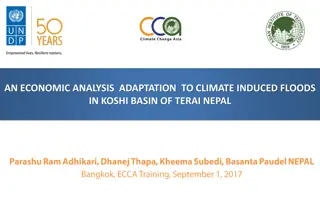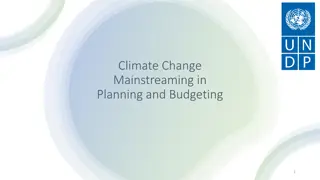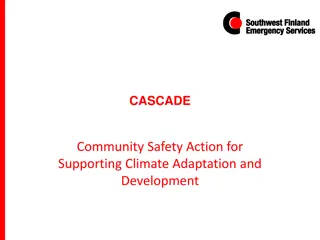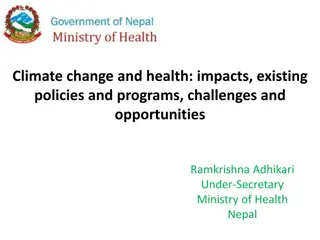Integrate Climate Change into Nepal's Macro-Structural Model
This model explores the integration of climate change effects into Nepal's macro-structural framework, focusing on impacts such as higher temperatures, changes in rainfall patterns, and extreme weather events. It considers effects on the economy, GHG emissions, transition risks, and policies for mitigation and adaptation. The model accounts for opportunity costs, growth effects, fiscal sustainability, and distributional impacts, highlighting the importance of addressing climate change in national economic planning.
Download Presentation

Please find below an Image/Link to download the presentation.
The content on the website is provided AS IS for your information and personal use only. It may not be sold, licensed, or shared on other websites without obtaining consent from the author.If you encounter any issues during the download, it is possible that the publisher has removed the file from their server.
You are allowed to download the files provided on this website for personal or commercial use, subject to the condition that they are used lawfully. All files are the property of their respective owners.
The content on the website is provided AS IS for your information and personal use only. It may not be sold, licensed, or shared on other websites without obtaining consent from the author.
E N D
Presentation Transcript
Integrating Climate Change to Nepal Macro-structural Model
Contents 1. MFMSA_NPL with climate extensions a. Energy sector b. Damage c. Adaptation 2. Select RCP impact results 1
1. MFMSA_NPL with climate extensions: general framework Climate impacts on economy: Higher temperatures; changes in rain patterns variability and quantities; increased incidence of extreme weather yield Lower agricultural and labor productivity; Damages to capital stock and interruptions in activity (floods; wildfires; storms) Economy s effect on climate: GHG emissions (power-sector; transportation; land use; industrial sources; agriculture); local air pollution (contributes to lower labor supply and productivity) Transition risks sudden revaluations of carbon intensive activities (firm evaluations; bank collateral; bank stress; risk premia) Policies to reduce each: carbon pricing; carbon trading regimes; regulatory approaches; subsidy reform; disaster risk management strategies (including adaptation investments) Models are general equilibrium in nature: account for opportunity costs; growth effects; direct and indirect effects; fiscal sustainability; currency sustainability; and distributional effects. 2
1. MFMSA_NPL with climate extensions: general framework Economy GHG Emissions Climate 4
1. MFMSA_NPL with climate extensions: specific implementation Built upon an existing standalone model MFMSA_NPL (time series, annual, national, general equilibrium): Richer NIA, Fiscal, Monetary, External Account representation International linkages: trade, commodities, remittances, travel receipts (Most) Behavioral equations in Error Correction representation separate out LR and SR properties Short- and medium-run disequilibrium allowed, long-run equilibrium to long-run anchors (growth rates: real potential output, prices inflation expectation) Climate elements added in: NIA-Production breakdown: Agriculture (total) Water Energy (=Electricity + Non- Electricity) Other Industry Services; IO mapping to final & intermediate demand Energy sector factored in both demand and production side; further disaggregated by fuel type (Coal Oil Gas Biofuels - Renewables: Hydro Solar); subsidies and commodity prices included to calculate true prices Pollution: functions of economic activity; 3 types of pollution considered: 1. PM2.5 from combustion: affects productivity and health expenditure 2. Energy CO2 pollution from combustion: of fossil fuels for energy 3. Economy-wide pollution: agriculture energy fugitive industry - waste Damage channels built in to treat 2 types of climate-related damages 1. Abrupt, destructive climate events: flooding destroys capital stock adaptation 2. Long-run, gradual impact of higher temperature on productivity (labor and agriculture) 5
1. MFMSA_NPL with climate extensions: a. Energy sector Input-Output table (GTAP10v1)to construct True energy input prices NPL Agriculture Energy Electricity Coke and petroleum c-petr Non-energy Services a-agri 792.0402 120.28 18.38695 101.8954 Energy a-elec a-petr a-non-ener a-serv c_g 0.0002391 4948.2439 0.0127559 129.47053 0.00 931.79 0 386.75456 0 545.04025 17.721048 5998.162 4820.8118 830.46773 2658.7414 6031.2348 482.50832 979.57161 c_p i_pg cty_x grand_total 7103.394454 1997.34 801.9841577 1195.352754 16480.25362 15845.0619 c-agri 0.00 6.66E-07 1.58E-08 1090.674 142.9527 38.50 38.48 0.02 7.17 7.156497 0.016313 237.4824 152.1829 31.33 31.32562 2.71E-06 11.31007 505.7638 197.44 193.4967 3.939905 2190.099 2030.505 177.20 176.4992 0.697934 248.79 657.95 0.00 0.02 c-elec 0 0.0045438 0 0.0176514 c-non-ener395.0504 c-serv 298.2997 2313.95 2903.558 Value added Capital Labor Taxes Direct taxes Export taxes total_va capital labor tot_taxes 222.3677 4761.144 2130.083 2631.061 226.12 225.9546 0.165619 2346.153 7972.813 192.62 192.4996 0.121097 1792.745 4189.113 33.50 33.45499 0.044522 553.4078 3783.699 219.13 55.371 163.7625 1797.352 1084.387 2676.46 17909.44 5303.33 1939.53 3323.24 x_tax fact_tax m_tax prod_tax sales_tax imports 0.074874 134.4545 49.76635 20.09145 17.98052 514.21 0.00 6.21 6.205151 0.004587 64.82609 223.9553 162.96 0.221013 162.7438 913.0596 29.92 28.9306 0.98647 565.1823 639.6488 20.04 20.01424 0.027123 250.3446 220.7825 1138.95 112.1805 1026.771 6493.233 0 0.000491 3.939141 0 Import taxes Taxes on product Sales taxes Imports 0 1052.9 9199.29 grand_total 7103.395 1997.34 801.9841 1195.353 16480.25 15845.06 7
1. MFMSA_NPL with climate extensions: a. Energy sector Subsidies (IMF explicit only) to derive total demand (intermediate + final) 8
1. MFMSA_NPL with climate extensions: b. Damages Floodings (NPL) Nepal - Riverine floods Probability Damage (% of exposed value) 3.2 C of additional warming 45.95% 18.38% 9.19% 3.68% 1.84% 0.92% 0.61% Return Period 0.5 C of additional warming 1.5 C of additional warming 20 50 100 250 500 1000 1500 1.66% 2.55% 2.96% 3.67% 4.33% 4.62% 4.70% 7.07% 2.83% 1.41% 0.57% 0.28% 0.14% 0.09% 14.14% 5.66% 2.83% 1.13% 0.57% 0.28% 0.19% Source: UNISDR. 2015. Making Development Sustainable: The Future of Disaster Risk Management. Global Assessment Report on Disaster Risk Reduction. 10
1. MFMSA_NPL with climate extensions: b. Damages Floodings (NPL) Frequency of flooding rises with temperature ? ? = ?? ?? ?? ? is the temperature ?0 is the historical index Flood damages destroy physical capital stock: ? ? ? ??? ? ? = ? + ? ???? ?? ?? ? ???? ???? Damaged capital is equal to an accumulation of capital that gets destroyed less reconstruction investment: ? ???= ??? ?+ ?? ?? 11
1. MFMSA_NPL with climate extensions: b. Damages Labor Productivity due to Heat Stress (NPL) ??? ? ? ? ? = ? + ? ???? ?? ?? ? ???? 12
1. MFMSA_NPL with climate extensions: b. Damages Agriculture Output (South Asia) ??? ? ? ? ? = ? + ? ???? ?? ?? ? ???? 13
2. Select RCP Impact Results Debt ppts ppts 1.2 1.0 0.8 0.6 0.4 0.2 0.0 -0.2 -0.4 -0.6 2020 2030 2040 2050 RCP 2.6 RCP 4.5 RCP 8.5 14
